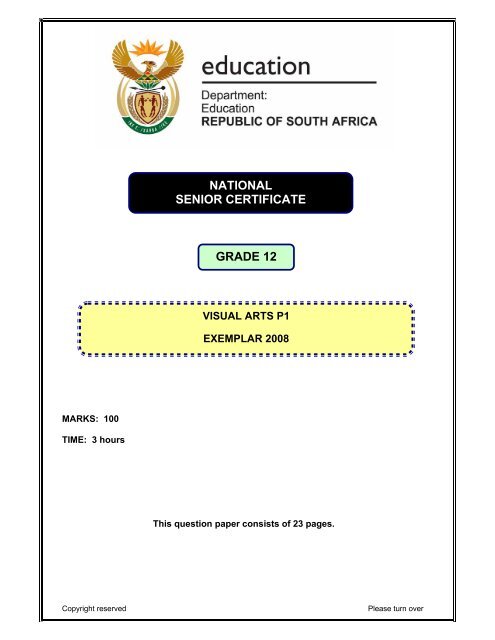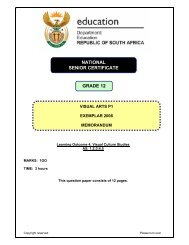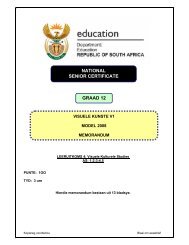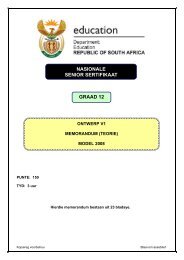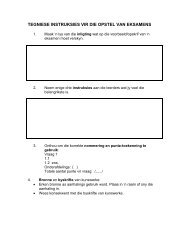NATIONAL SENIOR CERTIFICATE GRADE 12
NATIONAL SENIOR CERTIFICATE GRADE 12
NATIONAL SENIOR CERTIFICATE GRADE 12
- No tags were found...
Create successful ePaper yourself
Turn your PDF publications into a flip-book with our unique Google optimized e-Paper software.
<strong>NATIONAL</strong><strong>SENIOR</strong> <strong>CERTIFICATE</strong><strong>GRADE</strong> <strong>12</strong>VISUAL ARTS P1EXEMPLAR 2008MARKS: 100TIME: 3 hoursThis question paper consists of 23 pages.Copyright reservedPlease turn over
Visual Arts/P1 2 DoE/Exemplar 2008NSCINSTRUCTIONS AND INFORMATIONIn this examination you must demonstrate the following skills:• The use of correct art terminology• The use and implementation of visual analysis and critical thinking• Writing and research skills within a historical and cultural context• The placing of specific examples into a social and historical context• An understanding of distinctive artistic and creative stylesRead the following instructions before deciding on which questions to answer.1.2.3.4.5.6.7.8.Answer any FIVE questions for a total of 100 marks.Number the answers and sub-sections correctly according to the numberingsystem used in this question paper.Questions appear on the left-hand pages, with visual sources on the righthandpages.Ensure that you refer to the reproduced colour visual sources where requiredto do so.No marks will be awarded for information discussed in one answer if repeatedin other answers. Cross-referencing of artworks is permissible.Name the artist and title of each artwork you refer to.Write in a clear, creative and ordered manner, using full sentences andparagraphs where applicable.Write clearly and legibly.Copyright reservedPlease turn over
Visual Arts/P1 3 DoE/Exemplar 2008NSCGLOSSARY OF TERMS USEDUse the following glossary of terms to make sure you understand how to approach aparticular question.Analyse:Compare:Discuss:Explain:Interpret:State:A detailed and logical discussion of the formal elements (such as line,colour, tone, format et cetera) and composition of the work.Point out differences and similarities in an ordered sequence within thesame argument.Present your point of view and give reasons for your statements.Clarify and give reasons for your statements.Analyse and evaluate (give an informed opinion). Contextualise andsubstantiate with specific examples.Say directly what you think – give your opinion as well as anexplanation.Copyright reservedPlease turn over
Visual Arts/P1 4 DoE/Exemplar 2008NSCQUESTION 1: THE EMERGING VOICE OF BLACK ART IN THE 1950s AND 1960s1.1Write a short essay (1 – 1½ pages) in which you compare the two paintings(FIGURES 1a and 1b) by considering the following aspects:1.21.3• Subject matter• Use of perspective• Composition• Use of form• Style of paintingWhich of these two paintings creates the most convincing feeling of the placeportrayed? Give reasons for your answer by referring to the specific details inthe artwork.Discuss the artwork of ONE overseas artist whose work you have studied,which gives you a similar sense of the people and/or places of his/her time.The artist chosen may fall into any time period but must NOT be fromAfrica/South Africa.(10)(2)(8)[20]Copyright reservedPlease turn over
Visual Arts/P1 5 DoE/Exemplar 2008NSCIn the paintings (FIGURES 1a and1b), Peter Clarke and Gerard Sekoto both portraysimilar everyday scenes.FIGURE 1a: Gerard Sekoto, Yellow houses – a street in Sophiatown, 1940.FIGURE 1b: Peter Clarke, Wind blowing on the Cape Flats, n.d.Copyright reservedPlease turn over
Visual Arts/P1 6 DoE/Exemplar 2008NSCQUESTION 2: SEARCH FOR AN AFRICAN IDENTITY IN SOUTH AFRICAN ARTSINCE 1950'Our nation is moving forward into an era during which the interwoven, seamlesshistories of its peoples will be dominant in shaping our national identity. Clearly, weare, as a people, looking to the past to make sense of our identity in the present.'[Thabo Mbeki, at the opening of the Origins Centre in Johannesburg on 7 March 2006]2.<strong>12</strong>.2In a paragraph, discuss how Skotnes and Battiss have created artworks thatevoke an African identity. Refer to the two visual sources in FIGURES 2aand 2b.Artists need to turn to the past in their search for their own cultural identity.Discuss this statement by referring to artworks by TWO artists who exploretheir own cultural identity. You may use South African/Pan African and/orWestern/European artists.You may use any of the following aspects as a guideline for your answer:• Inspiration/Influence/Sources• Communication and interpretation of a cultural identity• Formal elements• The art-making process• Any other themes and messages that are conveyed through theirartwork(5)(15)[20]Copyright reservedPlease turn over
Visual Arts/P1 7 DoE/Exemplar 2008NSCFIGURE 2a: Cecil Skotnes, Conversation, 1971.Coloured engraved wood panel.FIGURE 2b: Walter Battiss, Rock Artists, 1965. Oil on canvas.Copyright reservedPlease turn over
Visual Arts/P1 8 DoE/Exemplar 2008NSCQUESTION 3: ART AND POLITICS – RESISTANCE ARTThe two artworks by Jane Alexander and Norman Catherine were created during the1980s in South Africa, when many artists protested through their work against the evilsof apartheid. In both these artworks the images/symbols of the oppressors (the peoplewho upheld the apartheid system) are shown in an aggressive, disturbing manner.With reference to the above statement write an essay (minimum 2 pages) in which youdo the following:• Discuss and compare the ways in which the oppressors are portrayed andsymbolised in the artworks by Jane Alexander and Norman Catherine (FIGURES3a and 3b) by referring to the following:• Possible meaning(s) of the title of each work• The use of art elements such as shape, texture, et cetera• Reasons for the use of both human and animal elements• Reasons for the use of different mediums in the work of these two artists• You may also include ONE other artist you have studied, who has responded to theapartheid system and/or other issues affecting the society he/she lived in. [20]Copyright reservedPlease turn over
Visual Arts/P1 9 DoE/Exemplar 2008NSCFIGURE 3a: Jane Alexander, The Butcher Boys, 1985. Mixedmedia including plaster, bone and a wooden bench.FIGURE 3b: Norman Catherine, Dog of War, 1988. Etching.Copyright reservedPlease turn over
Visual Arts/P1 10 DoE/Exemplar 2008NSCQUESTION 4: CRAFT AND APPLIED ARTCraftwork has recently become a 'trendy' fashion that is sought after by interiordesigners, fashion gurus and tourists alike. Its status has gone from low to high, wheregood craft artists can now command excellent prices for their creations.Esther Mahlangu practises traditional Ndebele wall art. Her work has beeninternationally acclaimed and she has exhibited all over the world for nearly 15 years.She also applies these wall patterns and shapes on canvas and other objects such asthe painted shoes and the BMW.4.14.24.3By referring to all the visual sources provided in FIGURES 4a – 4d, explain ina paragraph your understanding of the much-debated issue between what isconsidered to be 'fine art' or 'craft'.Mahlangu says that these days she sees her art as a commercial commoditythat empowers the women of previously disadvantaged communities and notas a statement about her community.Using the images provided in FIGURES 4a – 4d or any others of your choice,explain how the crafts can contribute significantly to the upliftment of the artist,the community and the country.Discuss the use of materials and techniques in the work of any other SouthAfrican craft artist you have studied.(5)(5)(10)[20]Copyright reservedPlease turn over
Visual Arts/P1 11 DoE/Exemplar 2008NSCFIGURE 4b: Esther Mahlangu, Untitled, n.d.Acrylic paint on canvas.FIGURE 4a: Ndebele-inspired fashion outfit. FIGURE 4c: Esther Mahlangu, SA ahead, 2003.FIGURE 4d: Esther Mahlangu, Painted BMW, 1991.Copyright reservedPlease turn over
Visual Arts/P1 <strong>12</strong> DoE/Exemplar 2008NSCQUESTION 5: ART AND POWER – COMMEMORATIVE BUILDINGS, MEMORIALSAND ARTWORKSFrom time immemorial, structures have been built to symbolise power or status. Fromancient Egyptian temples to Gothic cathedrals in Europe, to the twentieth and twentyfirstcentury skyscrapers, often referred to as 'cathedrals to wealth', man has alwaysexpressed a need to represent his achievements in this manner.By referring to the above statement and the images provided in FIGURES 5a – 5d, orthose of your own choice, write a short essay (2 – 3 pages) in which you include thefollowing:• Names of examples discussed• Use of materials and techniques• Significance of the site of the building/structure• Purpose/Function of the building/structure• Discussion of decorative features/imagery where applicable• Your response to these structures and their meaning/significance [20]Copyright reservedPlease turn over
Visual Arts/P1 13 DoE/Exemplar 2008NSCFIGURE 5a: The Arch of Constantine, Rome..FIGURE 5b: Gerhard Moerdyk, VoortrekkerMonument, PretoriaFIGURE 5c: Mies van der Rohe, The SeagramBuilding, New York.FIGURE 5d: Helmut Jahn,De Beers Headquarters, 11 Diagonal Street,Johannesburg.Copyright reservedPlease turn over
Visual Arts/P1 14 DoE/Exemplar 2008NSCQUESTION 6:THE ROLE OF THE FORMAL AND INFORMAL ART CENTRES INTHE TRAINING OF ARTISTS IN SOUTH AFRICA DURINGAPARTHEID/POST APARTHEIDIn the late 1960s and 1970s, Rorke's Drift in KwaZulu-Natal became one of the mostimportant training centres for black artists. Its aims were to nurture the unique artisticheritage of Africa and to extend this heritage with new influences, so that it would findits rightful place in an evolving and changing society.Cyprian Shilakoe and Dan Rakgoathe were two exceptionally important artists whoboth trained at the Rorke's Drift Art Centre.6.16.2By comparing and discussing the artworks in FIGURES 6a and 6b, especiallywith regard to the use of the formal elements, technique and mood, say whichartwork you feel, is visually the most successful piece. Give reasons for youranswer.Write a paragraph in which you discuss and analyse TWO other artworks byartists who trained at the Rorke's Drift, Polly Street, or Nyanga Art Centres.Include in your discussion the important role this/these centre(s) played in thetraining of black artists.(8)(<strong>12</strong>)[20]Copyright reservedPlease turn over
Visual Arts/P1 15 DoE/Exemplar 2008NSCFIGURE 6a: Dan Rakgoathe, Council of Solace, 1973.Lino cut, 43 x 41,5 cm.Dan Rakgoathe wrote the following words to his workCouncil of Solace as appeared on the exhibition cardto his 1989 retrospective show:'Beloved, stay well …May peace profound remain with youAnd solace light about you glowIn a flicker of flame of the trembling roseFarewell – 'FIGURE 6b: Cyprian Shilakoe, Let's wait till theyarrive, 1971. Etching.The intensity of his obsession with the spiritworld and the realm of dreams is evident inhis artworks. Shilakoe died tragically at ayoung age in a motor car accident. He hadthe following prophesy:'I am going to leave this world, but I will beback – and you people, you are going toremember me.'Copyright reservedPlease turn over
Visual Arts/P1 16 DoE/Exemplar 2008NSCQUESTION 7: MULTIMEDIA – ALTERNATIVE CONTEMPORARY AND POPULARART FORMS IN SOUTH AFRICAThere are some artists who do it for the money; others who do it just for themselves;and then there are the Jan van der Merwes of this world who do it for society, creatinga potent message for all to sit up and take notice.Van der Merwe is considered one of South Africa's major contemporary artists. In hisexhibition, The Archaeology of Time, are 30 years' worth of works, most in hissignature rusted metal and found objects. He deals with everything from women andchild abuse, to war, the effects of TV violence on kids, apartheid, life, death andeverything underpinned by a deep spiritual message.[Source: Unearthing the fragility of life, from an article by Geraldine Fröhling, Sunday Times, November 2006]7.1After studying the visual sources (FIGURES 7a – 7d) and the text above,write a short essay (1 – 1½ pages) using the following points as a guidelinefor your discussion:• The significance of the use of rust in the work of Van der Merwe andits connection to the title of his exhibition, The Archaeology of Time• How he has created a feeling of 'time passed by' in his installationWag (Waiting)• Any other relevant information based on the visual and writteninformation you have been given about this artwork(10)7.2Many contemporary artists that make relevant social commentary, usealternative media, such as installations.Discuss an artist whose work you have studied who has worked in thismanner. Substantiate whether the choice of medium adds to or detracts fromthe message and whether the work would have the same impact if executedin a traditional medium.(10)[20]Copyright reservedPlease turn over
Visual Arts/P1 17 DoE/Exemplar 2008NSCINSTALLATION BY JAN VAN DER MERWEThis installation honours the women and children of the Anglo-Boer War concentrationcamps, as well as those women and children of today that remain captive in situationsresulting from poverty and social upheaval.FIGURE 7a: Jan van der Merwe, Wag (Waiting), 2000.Rusted metal, found objects and clothing.FIGURE 7b: Jan van der Merwe, Wag(Waiting). Detail.FIGURE 7c: Jan van der Merwe, Wag (Waiting). Detail.FIGURE 7d: Jan van der Merwe, Wag(Waiting). Detail.Copyright reservedPlease turn over
Visual Arts/P1 18 DoE/Exemplar 2008NSCQUESTION 8: ART AND THE SPIRITUAL REALMThe expression of religious and/or spiritual concerns have always been a part of thevisual arts.8.18.28.3Do you think that the use of Bibles and Bible text in Wim Botha's installationadds to the meaning of the artwork, or could he just as well have used oldtelephone directories to create the form he needed? Substantiate youranswer in a short paragraph.Although Hlungwane and Peter Schütz have both worked with traditionalmaterials, their work is vastly different. Which of the two works do youconsider to be of a more religious/spiritual nature? Give reasons for youranswer.Discuss the work of any other artist from any time period that you havestudied, who also communicates a strong religious/spiritual message inhis/her work. You must include the following information in your discussion(1 – 1½ pages):• Name of artist and title of work• Medium used• Message/Content of the work(3)(5)(<strong>12</strong>)[20]Copyright reservedPlease turn over
Visual Arts/P1 19 DoE/Exemplar 2008NSCFIGURE 8a: Wim Botha, Commune:Suspension of Disbelief, 2001. CarvedBibles and Bible text. Installation.FIGURE 8b: Jackson Hlungwane, God and Christ,1990. Wood.Copyright reservedFIGURE 8c: Peter Schütz, Durban Icon, 1999.Wood and paint.Please turn over
Visual Arts/P1 20 DoE/Exemplar 2008NSCQUESTION 9: GENDER ISSUES9.1Discuss how the visual sources (FIGURES 9a – 9d) comment on the role ofmodern women. You must refer to the following in a short essay (1 – 1½pages):• How the media perpetuates certain images of women. Explain whatthe image in the advertisement (FIGURE 9a) conveys and how thiswas achieved• How the postures of the women (FIGURES 9a – 9d) comment on theirdifferent roles in society• Interpretation of the two works by Lisa Brice (FIGURES 9c – 9d), byreferring to the media, titles and any other elements used9.2• How these artworks (FIGURES 9c – 9d) make one aware of concernsrelating to womenDiscuss another work by ONE artist who has explored feminist/womenissues and/or any other issues relating to gender in his/her work. The artistmay be Pan African/South African or from overseas (1 page).(<strong>12</strong>)(8)[20]Copyright reservedPlease turn over
Visual Arts/P1 21 DoE/Exemplar 2008NSCFIGURE 9a: Vera Wang perfume advertisement. FIGURE 9b: Allen Jones, Chair and Girl Table, 1969.FIGURE 9c: Lisa Brice,Sex Kitten Cheap Cheap, 1990. Mixed media.FIGURE 9d: Lisa Brice, What is a home without anarmed mother?, 1995. Linoleum, wood, plaster.Copyright reservedPlease turn over
Visual Arts/P1 22 DoE/Exemplar 2008NSCQUESTION 10: SOUTH AFRICAN ARCHITECTUREIt could be said that South African architecture is simply a pastiche (bad copy) of stylesthat originated overseas.10.110.210.310.4Do you agree/disagree with the above statement? Give reasons for youranswer in a short paragraph.Do you think it is important that some of our architecture reflects a distinctlySouth African style? Substantiate your response in a short paragraph.If you were an architect commissioned to design a new high school in yourarea, what issues would you consider to be important when working on yourdesign?Discuss ONE building you have studied which you feel successfully reflectsour South African culture/identity/needs. This might be through thearchitectect's choice of design, materials, use of site or building techniques.You must name the architect and the building (1 – 1½ pages).(3)(3)(4)(10)[20]TOTAL: 100Copyright reservedPlease turn over
Visual Arts/P1 23 DoE/Exemplar 2008NSCFIGURE 10: A typical South African cityscape.Copyright reserved


